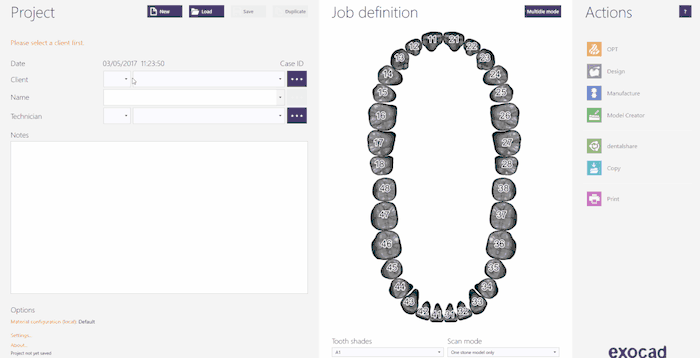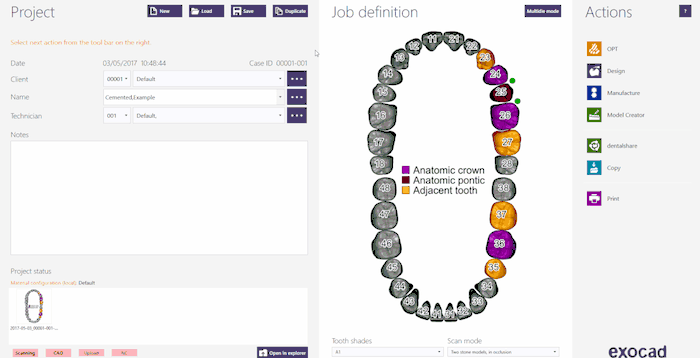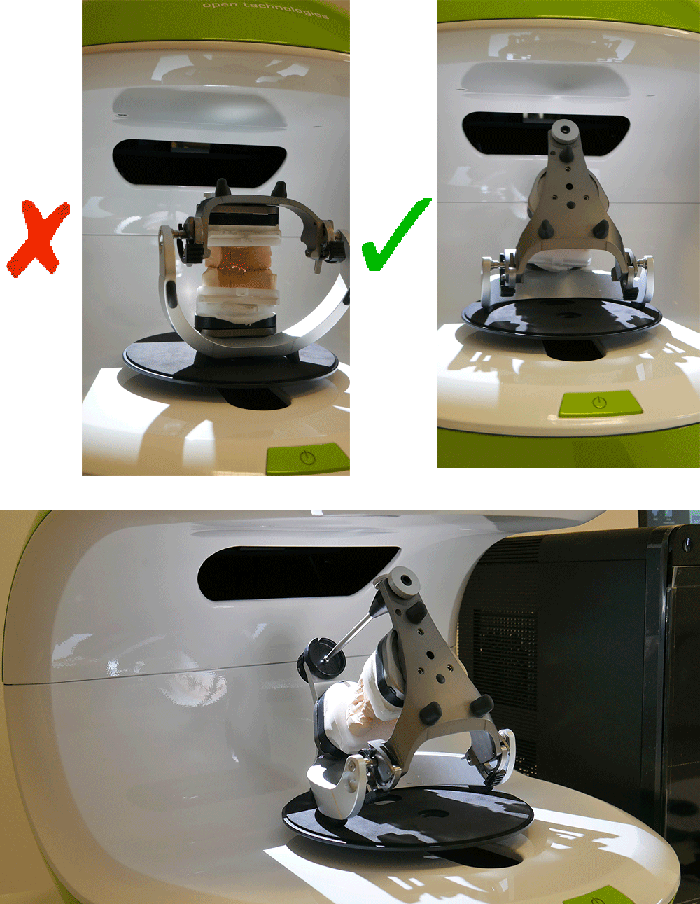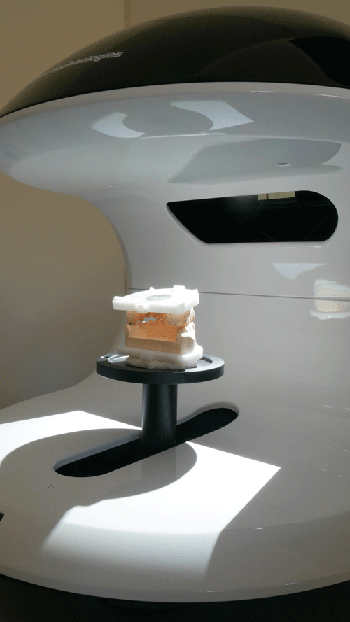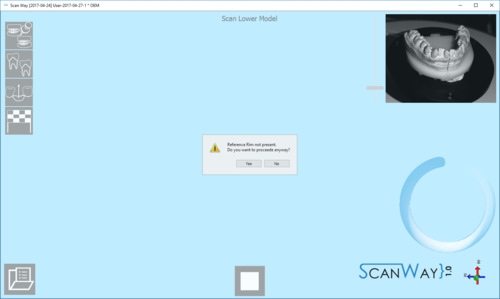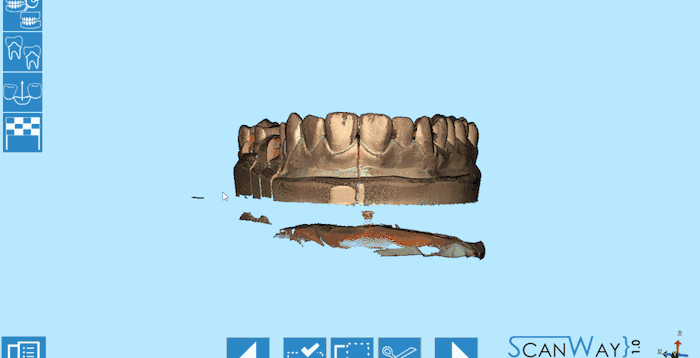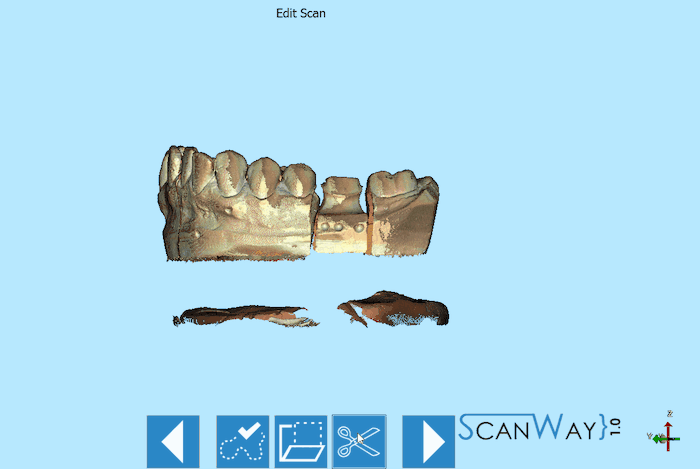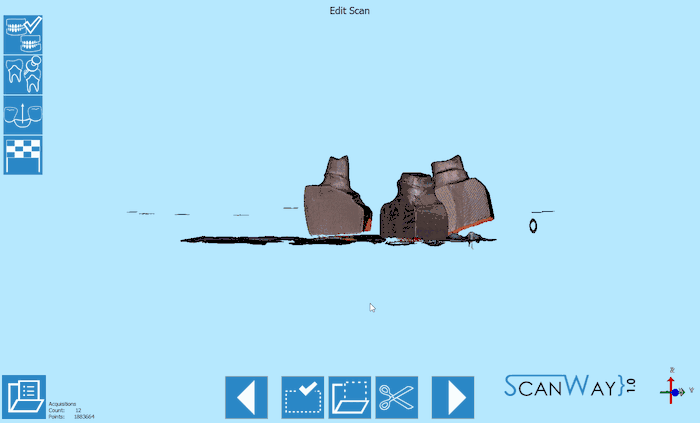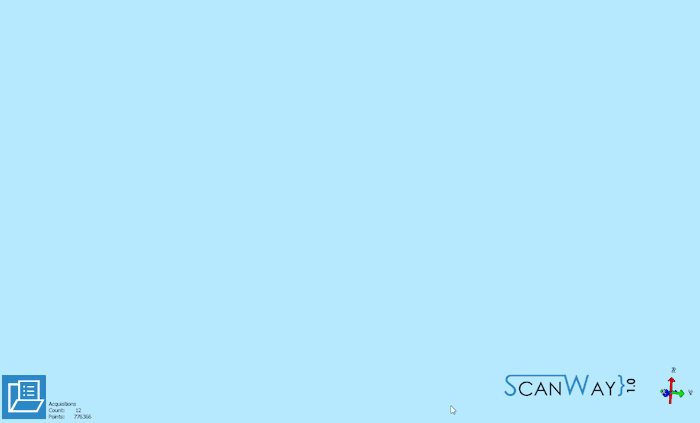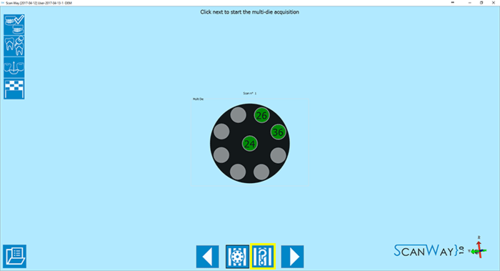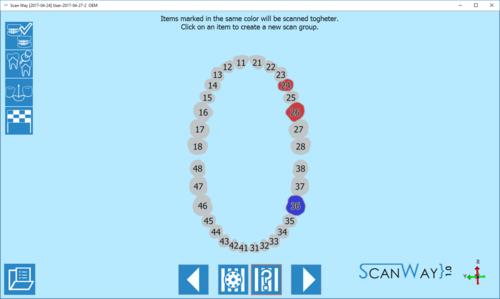Example: Cemented
In questa pagina è mostrata e spiegata la procedura guidata da seguire per scansionare 2 modelli in occlusione con 3 monconi (2 superiori e 1 inferiore).
Contents
Definizione del progetto in Exocad
Per creare questo progetto in Exocad, cliccare sull'icona DentalDB sul desktop, aprendo così il Gestore Progetti.
Inserire le informazioni del progetto, il tipo di ricostruzione che dovrà essere modellata e i parametri aggiuntivi. Per questo tipo di progetto assicurarsi che la Modalità Scansione sia impostata su Due modelli in occlusione.
Per maggiori informazioni su come creare progetti in Exocad, visitare la pagina Wiki Exocad!
Di seguito la definizione di un progetto esempio:
Una volta che il progetto è stato definito è sufficiente cliccare su OPT nella sezione Azioni per avviare il software di scansione.
Il software mostrerà come prima cosa il progetto creato in Exocad. Se il progetto è corretto, cliccare il pulsante Accetta ![]() .
.
Definizione del progetto da ScanWay
Tutti i progetti possono essere definiti nel software di scansione stesso, indipendentemente dal tipo di CAD che verrà poi utilizzato per la modellazione.
Avviare il software facendo doppio click sull'icona ScanWay sul desktop. Si aprirà la Pagina di Benvenuto; per creare il progetto cliccare sulla prima icona.
Per informazioni più dettagliate su come definire un progetto, visitare la pagina: Creare un Nuovo Progetto.
Di seguito la definizione del nostro progetto esempio:
Le definizioni di progetto sopra descritte portano entrambe ad avviare la medesima procedura guidata, che è composta dai passaggi seguenti.
Passaggio 1: Scansione Articolatore
Il primo passaggio di ogni progetto impostato con entrambe le arcate è la Scansione Articolatore.
Con Scansione Articolatore non si intende necessariamente che un articolatore deve essere scansionato; l'acquisizione richiesta è l'occlusione, sia che si usi un articolatore sull'apposita basetta sia inserendo semplicemente i due modelli in occlusione sul piattello.
Se è possibile scansionare l'occlusione con un articolatore, è consigliato inclinarlo all'indietro, per ottenere quanti più dati possibili. Questo suggerimento potrebbe non applicarsi a tutti gli articolatori dato che alcuni non possono essere inclinati.
Nella sezione Vista Live dell'interfaccia di scansione è possibile notare in effetti che se l'articolatore rimane dritto risulta difficile acquisire i dati in modo completo.
D'altro canto, come specificato in precedenza, è possibile acquisire i due modelli in occlusione sul piattello standard dello scanner, unendoli con degli elastici o della cera se necessario.
Una volta che i modelli sono stati inseriti nello scanner (con l'articolatore o uno sopra l'altro, in occlusione), è possibile avviare l'acquisizione con il Pulsante Scansiona![]() . A scansione terminata, i risultati verranno mostrati sullo schermo.
. A scansione terminata, i risultati verranno mostrati sullo schermo.
Per ulteriori informazioni sulle altre funzioni disponibili, visita la pagina Interaccia di Scansione.
Cliccare ![]() per accedere al secondo passaggio della modalità guidata.
per accedere al secondo passaggio della modalità guidata.
Passaggio 2: Arcata inferiore
Il secondo passaggio di ogni progetto con entrambe le arcate è la scansione del modello inferiore. Tutti i passaggi, escluso quello della scansione articolatore, prevedono due sotto-passaggi: la scansione e la modifica dell'immagine acquisita.
Scansione
Posizionare il modello inferiore sul piattello e cliccare il Pulsante Scansiona![]() . I risultati verranno mostrati sullo schermo.
. I risultati verranno mostrati sullo schermo.
Questa scansione è stata effettuata con l'ausilio dell'Anello di Riferimento. Ogni volta che al software viene chiesto di acquisire modelli, monconi o marker e l'anello di riferimento non è presente appare il seguente messaggio:
L'utente può quindi scegliere di annullare la scansione, inserire l'anello di riferimento e rifare la scansione, o acquisire senza usare l'anello di riferimento. Per ulteriori informazioni sull'anello di riferimento, consultare la pagina Accessories.
Cliccare ![]() per accedere al secondo punto del passaggio Arcata Inferiore.
per accedere al secondo punto del passaggio Arcata Inferiore.
Modifica
Questo passaggio permette di modificare l'immagine acquisita; per ulteriori informazioni sulle opzioni disponibili in questo passaggio consultare la pagina Strumenti di Modifica.
L'immagine a questo punto può essere modificata o ritagliata. A questo passaggio è fondamentale non modificare troppo l'immagine o non ritagliare considerevoli quantità di dati, questo perché il software ha successivamente bisogno di questi dati per effettuare l'allineamento automatico dell'oggetto con il suo riferimento.
L'immagine può essere modificata utilizzando gli strumenti di selezione.
Per il taglio basta semplicemente utilizzare lo strumento taglia base.
Una volta soddisfatti del risultato, cliccare ![]() per accedere al passaggio seguente.
per accedere al passaggio seguente.
Passaggio 3: Arcata superiore
La scansione dell'arcata superiore, così come quella dell'arcata inferiore, richiede due passaggi.
Scansione
Posizionare il modello superiore sul piattello e cliccare il Pulsante Scansiona![]() . I risultati dell'acquisizione verranno mostrati sullo schermo.
. I risultati dell'acquisizione verranno mostrati sullo schermo.
Come prima, se l'anello di riferimento non è stato inserito, il software mostra il relativo messaggio.
Cliccare ![]() per poter modificare i risultati ottenuti sul modello superiore.
per poter modificare i risultati ottenuti sul modello superiore.
Modifica
Come per il modello inferiore, anche per quello superiore è possibile apportare modifiche. Questa volta sarà mostrato uno strumento di modifica diverso.
Una volta soddisfatti del risultato, cliccare ![]() per accedere al passaggio seguente.
per accedere al passaggio seguente.
Salva e Allinea
Subito dopo che l'utente clicca il pulsante ![]() , il software salva e tenta in modo automatico di allineare gli oggetti scansionati al loro riferimento.
, il software salva e tenta in modo automatico di allineare gli oggetti scansionati al loro riferimento.
To learn more on the automatic alignment and the manual procedure visit our Alignment Interface page.
Step 4: Dies Scan
The steps necessary to successfully scan the dies vary depending on the scanning method that the user chooses to apply: the use of the multidie plate or the custom set-up.
With Multidie
This method is applied by default by the software. It implies that the user will put the dies on the multidie plate in the position shown by the software, which will make each die immediately recognisable and cut the steps of the wizard.
- Definition
- As mentioned, the position of the dies in the multidie plate is pre-established by the software.
The multidie order is based on the Universal tooth numbering, starting from the last element of the first quadrant and following in a clock-wise order. Therefore the die that needs to be placed in the central element will always be the one closest to the last element of the first quadrant.
If there are more than 9 dies, a second definition step will be shown.
Click ![]() to access the multidie scan step.
to access the multidie scan step.
- Scan
- The multidie scan interface is similar to the other steps we just explained, except for the multidie reference that is kept as a reminder on the right side of the window, under the live view.
To proceed click the Scan Button . Once the scan is finished the result will be shown.
. Once the scan is finished the result will be shown.
Click ![]() to access the edit step for the multidie scan.
to access the edit step for the multidie scan.
- Edit
- The edit step offers the same tools we saw in previous steps. In this case, more than one tool may need to be applied.
When you are satisfied with the result click ![]() to access the next wizard step.
to access the next wizard step.
- Alignment
- After being edited the dies get aligned to their references. The result is then showed on the monitor. To learn how to change, fix or redo the alignment check the Alignment Interface page.
Custom Set-Up (Without Multidie)
The user can also decide to scan the dies in a custom order, for instance if he needs to scan the dies on the model base. To access the custom set- up definition, click on the ![]() icon when the software presents the multidie definition.
icon when the software presents the multidie definition.
- Definition
- The software proposes by default a unique scan group which means that, if not defined otherwise, the software will ask the user to scan all the stumps together. In this case I have created a second scan group, to divide the scan of the upper dies from the scan of the lower dies. Click
 to access the scan steps.
to access the scan steps.
- Scan
- Depending on the number of scan groups created, the software will propose one or more scanning steps.
First, the software requires the user to insert the dies in the scanner and acquire the items of the first group.
As a reminder, it marks the items to be scanned together on the right of the window, under the live view.
Then it will ask the user to insert the item selected for the second group. Since the second scan is an individual die, there will be no reminder on the right. Click ![]() to continue.
to continue.
- Dies Identification
- When a scan group has more than one item, the user will be asked to separate each die from the others to correctly identify it.
This step occurs in between the scanning steps. To learn more on the identification of the dies visit the Scan Interface page. Click to continue.
to continue.
- Edit
- If the scan group is formed by one individual die, there will be no identification step. Instead, the edit step will be presented. Click
 to continue.
to continue.
- Alignment
- After being edited or identified the dies get aligned to their references. The result is then showed on the monitor. To learn how to change, fix or redo the alignment check the Alignment Interface page.
Step 5: Healthy and Pontics
At this stage the project has been scanned, unless the user wants to rescan the healthy and pontics. This step is infact a result of the scan of the scanned reference model, trimmed to exclude the parts that have been scanned individually (in this case, the dies). It sometimes happens that in the first model scan, the contact points on the healthy are not correctly recognised, which would require the user to rescan the model. Otherwise, just click ![]() to continue.
to continue.
The software will then propose a further edit step to allow the user to modify the healthy image. Proceed in the edit step as previously explained.
Step 6: Mesh Generation and Export
At this point the software immediately starts mesh generation. The meshes can be edited and exported individually or as a unique image. To learn more about mesh editing visit our Mesh Tools page.
Click on the Export Button ![]() to export to CAD.
to export to CAD.
If the project has been started from Exocad, the CAD will automatically open and the design can be started immediately. Otherwise the software will ask the user how to export the file.
